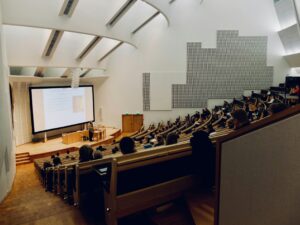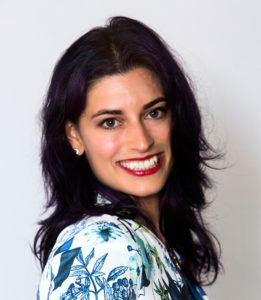
19 Feb The Failings of the Ivory Tower
The Failings of the Ivory Tower
By: Athena Matilsky
When I was 18, I decided I wanted to be an interpreter. Ever the logical goal-setter, I consulted professors in the field and reached out to friends of friends who might know something about this career—one that most people seemed to confuse with ‘translation’ or believe was only for ‘native speakers’ (native speakers of what, exactly?). The people who kindly guided me were my future colleagues, offering that first helping hand when I had no credentials—just a budding fluency in French and Spanish, and a dream.
You could say that my dream was achieved the day I first interpreted in court. But perhaps it was actually the day I became certified as a medical interpreter, or the day that I reached federal court certification. Or perhaps I’m not there yet, and I’m waiting until some nebulous day in the future?
Likely as not, there’s some truth to all those possibilities.
The truth is, dreams are achieved in stages. Certainly, one big, important moment was the day I earned my Master’s in Conference Interpreting (MCI)) from Glendon College of York University in Toronto, Canada. I have kept close ties to the university, serving as Healthcare Interpreting Field Coordinator and as an instructor in court interpreting for their MCI. The program helped me to solidify my skills and become the interpreter I am today.
Sadly, the Glendon MCI is now under threat from its own university as funds are cut, and impossible demands are placed upon its directors and administrators. University officials who don’t understand why an English instructor is not the appropriate teacher for a Mandarin-specific interpreting cohort, are pressuring the program to cut out all languages other than French and English and terminate contracts with their team of world-renowned international professors. The entire first year of the program, where the fundamentals of court and medical interpreting are established, is under threat as well. York University officials citing budgetary concerns seem not to recognize that their MCI has made them a global contender, placing the institution on the forefront of important international organizations that offer academic excellence second to none.
Now, not all of us can afford the luxury of a 2-year degree program, and I know many incredible court and medical interpreters—even some conference interpreters—who do not have a Master’s degree. However, even those of us who have not spent time in academia to achieve our interpreting credentials are benefiting from programs like the Glendon MCI; we attend webinars hosted by their graduates, we read their textbooks, and we train with their study materials even when we don’t realize it (think of the training that Holly Mikkelson received before creating her ACEBO trainings). The ethics and standards of our profession, the advocating for good working conditions and the factors that influence our pay are all impacted by what happens in those ivory towers.
Throughout North America, there are very few programs like Glendon’s—so few that you can count them on one hand. These intensive two-year programs offer a deep dive into all three branches of interpreting-medical, court and conference. Students from around the world are trained in theory, ethics and the hands-on skills that make high-level life-and-death interpretation possible. In the case of Glendon’s MCI, just eleven years since its inception, it has become one of the leading training programs of its kind. Their MCI graduates have gone on to the United Nations, the State Department, the European Commission and more. They have also become leaders in the fields of court and medical interpreting.
The implications of this threat are without measure. Programs like Glendon’s educate interpreters, who then facilitate equal access to healthcare and justice for the most vulnerable people in our society.
It was only a few years ago that doctors were asking untrained family members to deliver complicated cancer diagnoses. One horrifying example of what can happen in such circumstances was when somebody who “happened to know the language” mistakenly interpreted the cause of illness and the patient wound up paralyzed from the neck down; that person will spend the rest of their life in a wheelchair (source).
Similarly, until very recently, prisoners often arrived in jail not understanding what had landed them there because nobody thought to assign an interpreter. Even if they wanted to find somebody to interpret, nobody had the proper training to interpret correctly. If you were the victim of a heinous crime and the witness in a trial spoke a language other than that of majority, you would just have to hope that the jury got a fair idea of what was being said.
We have come far in a few decades, in part due to programs like Glendon’s MCI, but there is still much further to go. York University is training its Master’s graduates to be leaders in a very, very important field. Even among other academic institutions with similar degrees, the program is unique because of the hybrid nature of its training and the dynamic approach to the three interrelated disciplines. There are very few programs like the one at Glendon.
Dr. Clifford, the Glendon MCI director, has harnessed the best interpreting minds around the world. The teaching team includes veterans of the United Nations, The International Criminal Court, top European organizations, and renowned experts in the fields of community interpreting.
He has been aided in his efforts by Professor Qjinti Oblitas. Together, they teach most of the classes, coordinate admissions and academic exams and provide instructor support. When there is nobody at the office to respond to emails or pick up the phone, they step in and answer correspondence themselves. Yours truly has seen them at the university in the evenings and on weekends. This program is a labor of love, hard work and determination to provide the absolute best training possibilities to interpreting students all over the world. Shouldn’t an academic institution want to be a bastion of academic quality, bringing our society forward and making the world a better place? Doesn’t York University prize making its mark in history? Isn’t that the true reason for higher education, and not some dollar signs on a ledger?
My hope is that this is just a passing challenge and that York University does not continue to suffocate its own MCI. It is imperative that programs like this continue to exist. We need them, our future colleagues need them, and in a world that is ever more multicultural and multilingual, our society needs them.
We look forward to hearing your thoughts below in the comments!
Thank you for reading!
Keep the Conversation Going
If this topic resonated with you, be sure to check out our previous blog posts for more insights on the realities of our profession, and the evolving world of judiciary translation and interpreting:
-
- The Couch: Overcoming Imposter Syndrome — Exploring the challenges of self-doubt in the interpreting profession and strategies to build confidence.
- Listen to Your Body: Rest Now or Pay Later — A reminder of the importance of self-care and recognizing when to rest
- A Year of Growth, Gratitude, and Community – Welcome to 2025 — A reflection on the past year and a look ahead at the values shaping our community in 2025
- The Couch: Starting Fresh – Advice for New Graduates in Judiciary Translation and Interpreting — Practical advice and insights for new professionals stepping into the field
- Judiciary Translation vs. Judiciary Interpretation – Which Path Resonates with You? — A breakdown of key differences between these career paths to help you find the right fit
You can find these and more in our blog archives!
Interested in sharing your insights with our community? Check out Writing for The NAJIT Observer to learn how you can contribute.
The images used in this post are sourced from Unsplash. They are used for illustrative purposes only.
Hi everyone! I’m Athena Matilsky. My passion for languages began when I was sixteen. I loved how different languages opened a door into entirely new cultures. Learning how to speak felt like cracking a code. I chose to major in Spanish interpreting and translation at Rutgers University, while also studying French. After graduation, I taught elementary school in Honduras before returning home to freelance as a medical and court interpreter. I later joined the NJ judiciary as a staff interpreter. Through my journey, I earned certifications as a healthcare interpreter and a federal court interpreter in Spanish, and as a court interpreter in French. Most recently, I completed my Master’s Degree in Conference Interpreting from Glendon at York University. Nowadays, I work as a freelance medical, court, and conference interpreter. I am also a teacher for York University and Athena Sky Interpreting, helping students develop the skills needed to succeed in court, healthcare, and federal interpreting exams. Outside of work, I enjoy practicing acroyoga.





This is terrible, but I fear there is worse to come. Our profession is in great danger.
Our field suffers from academic neglect, if not outright hostility. Hardly unique to academia, unfortunately. It’s so frustrating to see so many programs suffering or being snuffed out. Over the past twenty or so years, we’ve lost an undergraduate minor at William Paterson State College in New Jersey, the MA in legal Interpretation at the College of Charleston, and conference interpreting graduate programs at Georgetown University and the University of Delaware. We have our work cut out for us!
Glendon was a life-changing experience for me. I can only imagine what universities and their number-crunchers have to go through.
One way to recognize the value of something is to imagine the world without it. Cars get a bad rap but try to imagine your city working without them for one day. So, think of interpreters and what the world would be like without them. If interpreters play an essential role in human society, it makes sense for them to pursue excellence, just as we need excellent plumbers, accountants, pilots, police officers, and so on. This program is that search for excellence.
You have lower-tier markets and those have a right to exist. But it’s also okay for there to be an elite. I hope York University will make the right choices, and I know budgets are tight. I hope this article and people’s comments can keep the overall picture in people’s minds (if anyone with decision-making power from York is reading this!).
As I write this, I am laying on a hospital bed due to back pain. When I was being checked in, I noticed the room had a nifty iPad stand with the words, “Telephonic Interpreting” ready to be used by the medical staff. Knowing I’m a court interpreter, my sister pointed at the device and told me to check it out. Hearing us talking, the nurse gave an unprompted look and remark of knowing, long-standing disappointment: “yeah, the usual interpreters we get on there leave much to be desired. You could tell their training is insufficient.”
This is not the first time I have heard this complaint from hospital and clinical staff. I have heard from Healthcare/Medical Interpreters themselves about how their training is inadequate. Maybe some day soon, folks will realize that marketing interpreter courses as “40-hour trainings” was the single most stupid, inane and irresponsible decisions made in the language profession. It has watered down and fragmented our whole profession so much, and it is based solely on capitalist greed, a sad cornerstone of our broken healthcare system as a whole.
We have a consortium court exam across most of our states, developed and maintained by the National Center for State Courts, who have somehow, increasingly become the go-to experts on matters of court interpreting/translation. Yet their webinars and products rarely, if ever, include the input of actual court interpreters.
We have a large number of veteran colleagues who we are losing to retirement and no one in our court administration seems to care about harnessing their expertise and experience to advance the field or help mentor a younger generation. They have even dumbed down the once rigorous California court certification exam, what used to be the gold standard and birthplace of modern judicial interpreting in this country.. California is also where they now increasingly use non-certified interpreters to work in court, and where they plan to soon use “near-passers” to fill our ranks.
And whoever thought that social justice profiteering elements in our country would vie to trademark the term THE COMMUNITY INTERPRETER? As if court interpreters have not been the premier interpreters in our respective communities already; it was not elitism, it was reality. Their 40-hour nonsense overemphasizes Ethics and Logistics and does not focus on the meat and potatoes: terminology and technique. Now we have a whole swath of “bilingual” persons calling themselves Scholastic Interpreters and Community interpreters yet their rendition is steeped in Spanglish. Their hubris is based on overblown concepts like patient advocacy and cultural brokering. It doesn’t take a brain surgeon to realize that all this is merely meant to dumb down the Spanish language as a whole, arguing that working class Latinos are too unsophisticated to understand their own language when it is spoken/written well. Standards have been lowered everywhere because of this insidious, racist stereotype.
Then we court interpreters are surrounded by legions of “bilingual” professionals who work at the county/state/federal government agencies we call justice partners, such as Probation, Child Support Services, Public Defender, and District Attorney offices, etc. On the daily, they continually undermine our work with lousy interpretation and written material. Our language expertise is muted by the Spanglish screaming at us from outside the halls of justice. For God’s sake, we have “bilingual” cops who take the stand regularly and testify on their ability to translate during police interrogations that may elicit confessions, for instance! Their only qualification that seems to satisfy themselves, judges and BOTH litigators: “I grew up speaking Spanish, it’s my first language.” The ignorance is real.
I don’t doubt that Glendon has been a beneficial institution based on your description. You mentioned the late Holly Mikkelson’s work which I appreciate greatly. And there are other academic leaders who deserve not just mention but need to be brought into the fold and given true agency at our government institutions. By now, every state judiciary should have an OFFICE OF THE COURT INTERPRETER whereby WE decide the conditions and designs of everything from training to recruitment, from certification to ongoing support and maintenance of OUR profession. Instead of clamoring from the outside like NAJIT, ATA, and our labor unions, WE should be the ones making the decisions WITHIN the system.
So I agree with you. There is a disconnect between academia and the real world. But I think there is a larger picture. We are living, after all, in an anti-intellectual, Trumpian world that proudly eschews actual knowledge, research and quality education. It’s hurting all of us. But this problem has been festering for years. I hope it’s not too late.